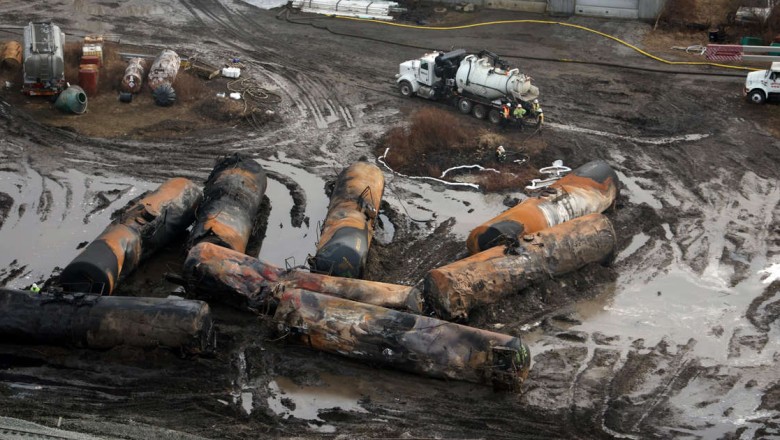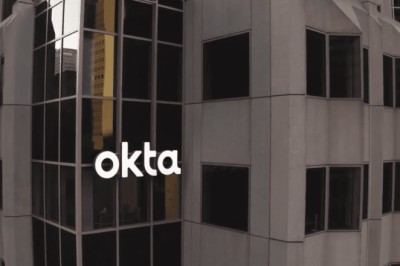
Five days after a train carrying vinyl chloride derailed and exploded near the Ohio-Pennsylvania border, crews ignited a controlled burn of toxic chemicals to prevent a much more dangerous explosion.
Thousands in East Palestine, a town of about 5,000 people, evacuated, and officials warned the controlled burn would create a phosgene and hydrogen chloride plume across the region. Phosgene is a highly toxic gas that can cause vomiting and breathing trouble, and was used as a weapon in the first world war.
Though no one died in the accident, the catastrophe serves as a wake-up call to the potential for more deadly freight rail derailments, public health advocates warn. By one estimate, 25 million Americans live in an oil train blast zone, and had the derailment occurred just a few miles east, it would be burning in downtown Pittsburgh, with tens of thousands of residents in immediate danger.
Ineffective oversight and a largely self-monitoring industry that has cut the nation’s rail workforce to the bone in recent years as it puts record profits over safety is responsible for the wreck, said Ron Kaminkow, an Amtrak locomotive engineer and former Norfolk Southern freight engineer.
“The Palestine wreck is the tip of the iceberg and a red flag,” said Kaminkow, who is secretary for the Railroad Workers United, a non-profit labor group that coordinates with the nation’s rail unions. “If something is not done, then it’s going to get worse, and the next derailment could be cataclysmic.”
About 4.5m tons of toxic chemicals are shipped by rail each year and an average of 12,000 rail cars carrying hazardous materials pass through cities and towns each day, according to the US Department of Transportation.
The latest accident comes after 47 people were killed in the town of Lac-Megantic, Quebec, in 2013 when a runaway train exploded. In February 2020, a crude oil train derailed and exploded outside Guernsey, Saskatchewan, and an ethanol train in Kentucky derailed and burst into flames a week later.
The Pittsburgh region alone has seen eight train derailments over the last five years, according to the public health advocacy group Rail Pollution Protection Pittsburgh (RPPP), and about 1,700 annually occur nationally. The causes of the Pittsburgh accidents highlight the myriad ways in which things can go wrong. A crack in a track ignored by rail companies caused a 2018 derailment, while another train hit a dump truck at a crossing with inadequate safety equipment. A broken axle on a train car is thought to be the source of the East Palestine accident.
Up to 50% of volatile Bakken crude oil refined on the east coast currently runs through metro Pittsburgh, RPPP estimated, and about 176,000 Pittsburghers live in the derailment blast zone.
Rail traffic is projected to increase through the region as a new Shell plastic plant comes online and rail infrastructure, like tracks and bridges, are in a precarious state, said Glenn Olcrest, founder of RPPP.
“The railroads are playing Russian roulette with Pittsburgh,” he said. “We are a prime candidate for a major derailment and explosion.”
Still, the US transportation department (DoT) in 2020 approved a rule to allow liquified natural gas, or LNG, to be shipped via rail with no additional safety regulations. Trains can now run 100 or more tank cars filled with 30,000 gallons of the substance, largely from shale fields to saltwater ports.
The decision was opposed by local leaders, unions, fire departments and the NTSB.
“The risks of catastrophic LNG releases in accidents is too great not to have operational controls in place before large blocks of tank cars and unit trains proliferate,” the NTSB wrote in a comment on the proposed rule.
Just 22 train tank cars filled with LNG hold the same amount of energy as the Hiroshima bomb, a coalition of environmental groups wrote in comments to regulators opposing the LNG rail rule change in 2020. That is raising fears of a catastrophe if a proposed LNG port is built in New Jersey, which could take shipments from two 100-car trains daily that would run through nearby metro Philadelphia.
An LNG fire is extremely difficult for local crews to contain, and shipping it via rail is “an extremely dangerous practice”, said Natural Resources Defense Council senior attorney Kimberly Ong.
“We’ve been astonished by the effect that the spillage of five cars of vinyl chloride has had at the Pennsylvania-Ohio border, but that would be nothing compared to the effects of a similar derailment of LNG,” she added.
In Florida, plans to expand passenger rail service also seem designed to increase LNG shipment capacity by the company behind the effort, said Susan Mehiel, coordinator of the Alliance for Safer Trains. The public safety advocacy group fears higher-speed passenger trains sharing tracks with freight trains carrying LNG and other chemicals could ignite a disaster like that in East Palestine.
Eastern Ohio is less dense than most of where Florida’s lines run, Mehiel added. An LNG explosion in denser east Florida would likely be much more deadly, she said.
“There’s no evacuation because you’re dead, so it’s very frightening,” Mehiel said.
Under the Biden administration, the transportation department has proposed a suspension of the Trump-era LNG rule allowing the substance to be transported via rail and to replace it with a new rule. The suspension was supposed to be published by June 2022, but it and the new rule have been delayed twice, and are now supposed to be final in March, Ong said.
“I don’t know if this is a priority for DoT,” she added.
The Railroad Workers United pinned the threat on rail industry cuts to inspection staff and the elimination of safety protocol. The East Palestine train was hurried, the non-profit said in a statement, and though a cause hasn’t been fully determined, it appears the train was not properly inspected.
Rail companies laid off more than 20,000 rail workers during a year period in 2018-2019, representing the biggest layoffs in rail since the Great Recession, and the nation’s rail force has dipped below 200,000 – the lowest level ever, and down from 1 million at its peak.
“They have cut the hell out of the workforce, and there are big plans to cut it further,” Kaminkow said. “Just because the rail companies are profitable doesn’t mean they’re healthy.”
https://www.bing.com/news/search?q=site%3awww.msn.com&FORM=NWBCLM











Comments
0 comment